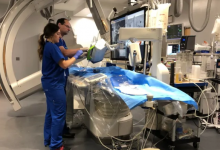Toronto neurosurgeon marks 1,000th operation treating ‘excruciating’ facial pain syndrome
More than three years after Maureen Shaughnessy Kitts first experienced debilitating pain on the right side of her face, she still finds it hard to properly describe the sensation.
The pain might come on while she brushed her teeth, or sometimes, after a gentle gust of wind blew on her cheek. The result was something like an “electric shock,” she said, with no obvious cause.
It later evolved into a “constant and excruciating” sensation. When asked by doctors to rate the pain from one to 10, she said it was a 13.
“I was thinking, ‘Was I imagining this pain? Where did it come from? Why is it here?'” recalled Shaughnessy Kitts.
But today, the bizarre and intense pain is merely an unpleasant memory thanks to the Toronto neurosurgeon Dr. Mojgan Hodaie.
“I am feeling so terrific and so thankful and so grateful,” Shaughnessy Kitts told CBC Toronto.
“Through a miracle of neurosurgery I am who I am today: totally pain free.”

Trigeminal neuralgia
Shaugnessy Kitts was diagnosed in late 2016 with the rare and severe pain condition trigeminal neuralgia (TN), which is sometimes known as “the suicide disease.”
It is brought on when the brain’s trigeminal nerve, which carries sensation from the brain to the face, is disrupted, sending unfounded but very powerful pain signals to the brain.
Researchers estimate that around five in 100,000 people may have the condition, but it is notoriously difficult to diagnose since the symptoms can overlap with other conditions and accurately describing the pain can be challenging for patients.
The issue, however, can be resolved through surgery, though only a handful of Canadian doctors have the expertise to perform the operation.
Dr. Hodaie, who works at the Krembil Brain Institute at Toronto Western Hospital, is the leader among them. She descibes TN as “a thunderbolt of extremely severe electrical pain.”
She operated on Shaughnessy Kitts in April 2017 and marked her 1,000th surgery related to TN in early December.
“There’s no doubt it’s extremely rewarding for us to know that we’re able to operate on patients and they are pain free,” she said in her office.
“It’s one of the very few pain syndromes that we’re actually able to achieve pain freedom.”
‘Oh my God, she’s done this’
During a typical TN surgery, Dr. Hodaie begins by making an incision in the skull and probing to the site of the trigeminal nerve, which is around nine centimetres into the brain.
In some cases, the nerve is pinned by an errant blood vessel, which Dr. Hodaie repositions before placing a miniscule Teflon barrier to prevent contact from reoccurring.
The procedure takes around 90 minutes and Dr. Hodaie routinely performs several such operations in a single day. The surgery took about six hours when it was first developed around 40 years ago, she explained.
About 90 per cent of patients report a loss of pain immediately after the surgery, while around 75 per cent remain pain-free five years after the operation.
Shaughnessy Kitts recalled waking up after her procedure stunned that her pain had disappeared.
“I just felt, ‘Oh, my God, she’s done this.’ And I don’t want to experience it again,” she said.
Doctors seeking greater understanding of pain
In addition to her busy surgery schedule, Dr. Hodaie also researches TN and trains a small team of fellows studying pain syndromes.
Her goal, she said, is to advance the medical understanding of pain and introduce new objectivity to its diagnosis and treatment.
“We are working very strongly to figure out why does this pain happen in the first place, and why is it that our brain is able to perceive pain that is so strong,” Dr. Hodaie told CBC Toronto.
A more thorough understanding of TN could ensure that more patients are properly diagnosed and able to receive treatment to resolve the pain, which can also include medication, injections and radiation.
Dr. Hodaie and her team are also developing new brain imaging techniques that may help medical professionals to accurately identify different types of pain and their resulting effects on the brain.
CBC







Redes Sociais - Comentários